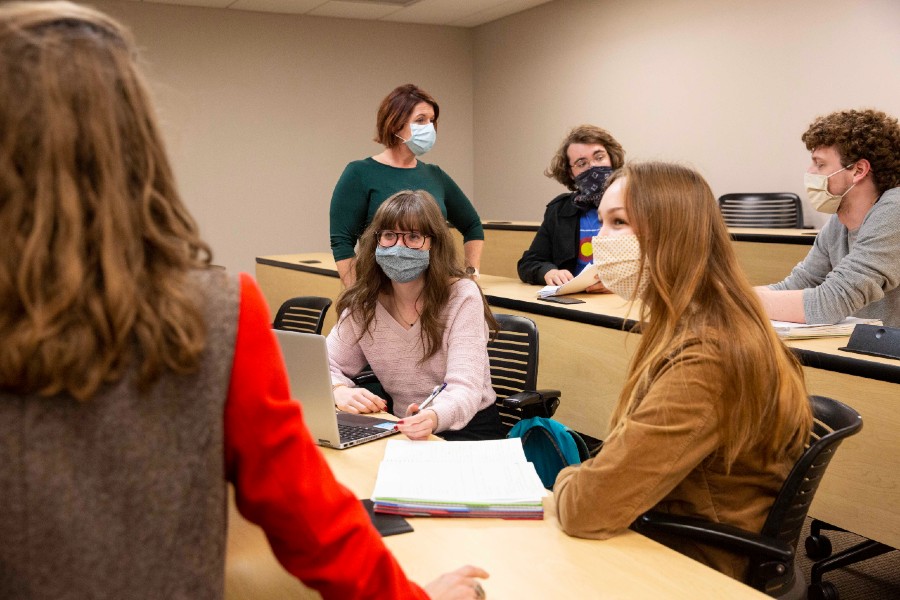Honors students say 'yes' to How Language Works course
The interdisciplinary LIGHT and Engagements course asks big questions and promotes wrestling with assumptions.
Janel Shoun-Smith | 615.966.7078 |

Reflecting on the many historic milestones the past year has brought, it is obvious it was a particularly interesting time to study the impact and influence of language.
From political milestones to grassroots uprisings, from increased use of video-conferencing to re-thinking how we worship and fellowship, 2020 was a year that had everyone thinking about how we talk and relate to one another and how we communicate.
So perhaps it is no surprise that How Language Works was one of the first honors courses to fill up in the fall of 2020. In fact, the popularity of the sophomore-level Engagements course has been growing ever since it was first offered in 2018.
“Students get excited because we ask the big questions, and the fact that they can raise any issue in class and we will address it really appeals to them,” said Cecelia Ramsey, lecturer in the Department of English and Modern Languages in the College of Liberal Arts & Sciences, who co-teaches the course with Associate Professor Kelly Kidder, also of the department.
Students get excited because we ask the big questions. — Cecilia Ramsey
“In addition to reading various memoirs, the class uses discourse analysis to study everything from advertisements to text messages. It is designed to teach students how to analyze language, to recognize how it impacts their lives, its practical uses and how to see themselves and others through a language lens,” said Kidder.
“Ever since taking this class I have been much more conscious about things that I never bothered to think about before, specifically what messages companies are trying to send me in their advertising and product design,” said Abigail Thompson, a sophomore from St. Louis, Missouri, who took the course “to dig into the actual theory behind these languages.
Since taking the course, “I have been very careful to buy things that present neutral messages, especially when it comes to things like birthday cards and gifts for children,” she said.
“It encourages self-reflection on how we want to be perceived by others and how we perceive ourselves,” said Ramsey. “And that also applies to us; we are constantly learning alongside our students, and every time we teach this course, the content changes because we base it on the interests and needs of our students at that time.”
This past fall was the first time that How Language Works was offered specifically for honors students only. Enrollees have grown from seven to 40 since the two French professors began offering the course.
Ever since taking this class I have been much more conscious about things that I never bothered to think about before. — Abigail Thompson
“Understanding how language works is a critical part of the liberal arts education,” said Kidder. “You never look for a job where the employer doesn’t say, ‘We want strong communication skills.’ A course like this really does benefit every person.”
"What stuck with me most was how men and women communicate differently in the workplace. It has made me more aware of how exactly I communicate and if there are things that I need to change," said Jason Stubblefield, a junior from Sesser, Illinois.
"I also realized that the process of recognizing separate languages is steeped in a lot of elitism and racism. This has made me reconsider any potential biases I had," Stubblefield said. "Additionally, I learned that the way someone speaks or the accent they may have often dictates others’ opinion of them. After this class, I realized the need to bury any preconceived notions I have about certain manners of speaking."
Lipscomb’s Engagement courses are sophomore-level, team-taught courses designed to dismantle the idea that English skills belong in just one class. These interdisciplinary courses focus on teaching critical thinking and communicating those thoughts by focusing on various disciplines other than English, such as science, physics, art or the natural environment.
In How Language Works, Ramsey's background in translation theory and Kidder's background in psychology and second language education combine to provide a deeper knowledge to guide students’ exploration of the relationship between language and identity.
Assignments have ranged from analyzing birthday card messages to analyzing political ads, from writing a memoir to playing an interactive game in which students create their own form of sign language.
“One of the most interesting things we did in this class was analyze some of the different messages that society sends to different audiences through advertising and through specific language choices,” said Thompson. “We focused on the non-dictated language like color choice and images. We talked a lot about how to properly dissect a piece of art, whether that be literature or visual art, throughout different thought processes presented by dominant figures in language theory.”
Understanding how language works is a critical part of the liberal arts education. — Kelly Kidder
“One of the big questions we ask is who are you without your words? Does language make you uniquely human? How do we responsibly use our language? And how do we use our language as Christians?” said Kidder.
Doubling as a LIGHT class, Lipscomb’s program to ensure intercultural competence in its academic offerings, How Language Works includes reading many memoirs that showcase a diverse range of language experiences.
Among the works read in the course are excerpts from The Hunger of Memory by Richard Rodriguez and Sharing the Work by Myra Strober, memoirs like “Mother Tongue” by Amy Tan and “Lakota Words” by Delphine Red Shirt, and articles from linguists such as Deborah Tannen, Lera Boroditsky and John McWhorter.
“This course provides a space for students to wrestle with and question assumptions they have held, and amplifies voices they may not have heard,” said Kidder. “These two aspects allow them to understand themselves and the world with more compassion and love.”